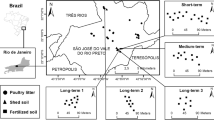Abstract
Mercury (Hg) is a non-essential element for plants and animals nutrition. Its presence in agricultural systems is of concern due to its high potential toxicity. Mercury is persistent in the environment and has been listed as a pollutant by several environmental organizations. This work focuses on Hg concentrations and distributions, trends, and relationships with some properties of soils that have received repeated broiler litter application and currently under pasture. Results revealed significant increase in Hg concentration from 41 to 105 μg kg−1 and downward transport in the fields due to repeated applications. Correlation analysis indicated that sulfur and soil bulk density significantly (0.626*** and −0.645*** at p ≤ 0.05, respectively) influenced its accumulation and distribution in this soil.


Similar content being viewed by others
References
Alabama Agriculture Statistics Service (1999) Commercial broilers. In: Production and value of production, 1990–1999, Ann Bull. Available via DIALOG. http://www.aces.edu/dept/nass/bulletin/1999/pg40.pdf. Accessed Jan 2002
Barkay T, Wagner-Dobler I (2005) Microbial transformations of mercury: potential, challenges, and achievements in controlling mercury toxicity in the environment. Adv Appl Microbiol 57:1–52. doi:10.1016/S0065-2164(05)57001-1
Bash JO, Miller DR (2007) A note on elevated total gaseous mercury concentrations downwind from an agriculture field during tilling. Sci Total Environ 388:379–388. doi:10.1016/j.scitotenv.2007.07.012
Grigal DF (2002) Inputs and outputs of mercury from terrestrial watersheds: a review. Environ Rev 10:1–39. doi:10.1139/a01-013
Hylander LD, Lindvall A, Gahnberg L (2006) High mercury emissions from dental clinics despite amalgam separator. Sci Total Environ 362:74–84. doi:10.1016/j.scitotenv.2005.06.008
Jamal SN, Iqbal MZ, Athar M (2006) Evaluation of two wheat varieties for phytotoxic effect of mercury on seed germination and seedling growth. Agric Conspec Sci 71:41–44
Jiang GB, Shi JB, Feng XB (2006) Mercury pollution in China. Environ Sci Technol 40:3672–3678. doi:10.1021/es062707c
Kpomblekou AK, Ankumah RO, Ajwa HA (2002) Trace and nontrace element contents of broiler litter. Commun Soil plant Anal 33:1799–1811
Loewen M, Kang S, Armstrog D, Zhang Q, Tomy G, Wang F (2007) Atmospheric transport of mercury to the Tibetan plateau. Environ Sci Technol 41:7632–7638. doi:10.1021/es0710398
Mirlean N, Baisch P, Machado I, Shumilin E (2008) Mercury contamination of soil as the result of long-term phosphate fertilizer production. Bull Environ Contam Toxicol 81:305–308. doi:10.1007/s00128-008-9480-z
Mutter J, Naumann J, Sadaghiana C, Schneider R, Walach H (2004) Alzheimer disease: mercury as pathogenetic factor and apolipoprotein E as a moderator. Neuroendocrinol lett 25:331–339
Nyakatawa EZ, Reddy KC, Brown GF (2001) Residual effect of poultry litter to cotton in conservation tillage systems on succeeding rye and corn. Field Crops Res 71:159–171. doi:10.1016/S0378-4290(01)00155-1
Pena LB, Zawoznik MS, Tomaro ML, Gallego SM (2008) Hemetals effects on proteolytic system in sunflower leaves. Chemosphere 72:741–746. doi:10.1016/j.chemosphere.2008.03.024
Roulet M, Lucotte M, Saint-Aubin A, Tran S, Rheault I, Farella N, Da Silva EDJ, Dezencourt J, Passos CJS, Soares GS, Guimaraes JRD, Mergler D, Amorim M (1998) The geochemistry of mercury in central Amazonian soils developed on the Alter-do-Chao formation of the lower Tapajos Rive valley, Para State, Brazil. Sci Total Environ 223:1–24. doi:10.1016/S0048-9697(98)00265-4
SAS Institute (1999) The SAS system for windows, version 8.1. SAS Inst., Cary, NC
Shaffer M (2001) Fertilizers contain toxic metals. In: waste lands. California pubic interest research group charitable trust, Los angles, p 11
Tazisong IA, Senwo ZN, Taylor RW (2005) Trends in trace elements in an ultisol impacted by long-term applied broiler litter. Bull Environ Contam Toxicol 75:975–981. doi:10:1007/s00128-005-0845-2
Tessier-Lavigne M, Mobbs P, Attwell D (1985) Lead and mercury toxicity and the rod light response. Invest Ophthalmol Vis Sci 26:1117–1123
Trasande L, Landrigan PJ, Schechter C (2005) Public health and economic consequences of methyl toxicity to the developing brain. Environ Health Prosp 113:590–596
Zheng YM, Liu YR, Hu HQ, He JZ (2008) Mercury in soils of three agricultural experimental stations with long-term fertilization in China. Chemosphere 72:1274–1278. doi:10.106/j.chemosphere.2008.04.052
Acknowledgments
This research is a contribution of the Winfred Thomas Agricultural Research Station, Alabama A&M University, Normal AL 35762, USA. Journal # 627.
Author information
Authors and Affiliations
Corresponding author
Rights and permissions
About this article
Cite this article
Tazisong, I., Senwo, Z. Mercury Concentration and Distribution in Soils Impacted by Long-Term Applied Broiler Litter. Bull Environ Contam Toxicol 83, 291–294 (2009). https://doi.org/10.1007/s00128-009-9783-8
Received:
Accepted:
Published:
Issue Date:
DOI: https://doi.org/10.1007/s00128-009-9783-8




